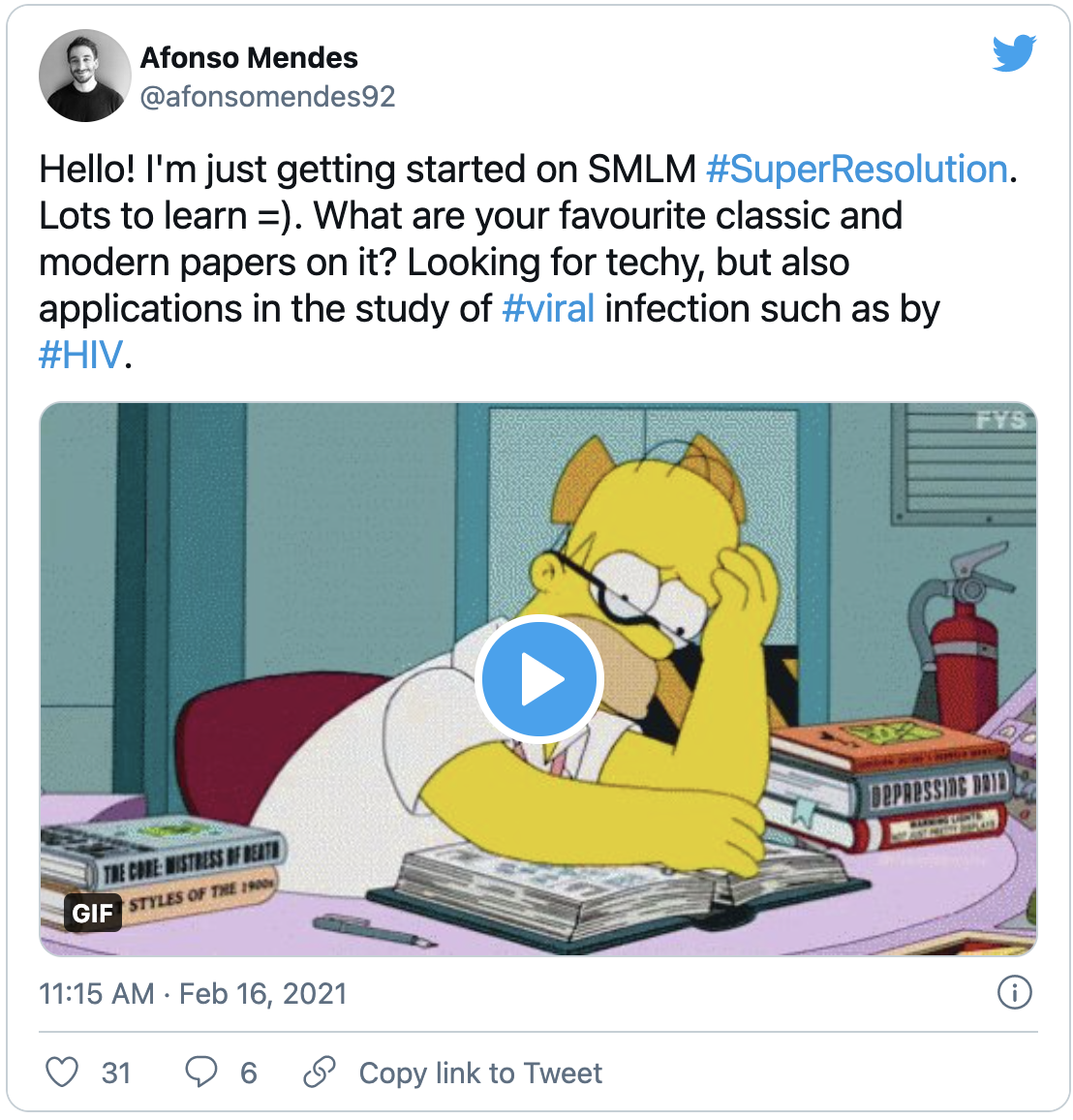A First Exposure to Super-Resolution Microscopy
Posted by Afonso Mendes, on 11 June 2021
Biomedical research encompasses several fields of expertise involving complex biological topics and technologies. Studying a given subject is a process that takes years, decades, and sometimes a lifetime to complete. Consequently, researchers tend to become highly familiar with a specific subset of scientific topics and experimental approaches. However, they are often confronted with the cumbersome (and somewhat frightening) task of exploring a topic outside their field of expertise.
A first look at the state-of-the-art of this new subject likely reveals a vast historical background, a seemingly endless amount of highly technical literature to “catch up” with, and sometimes a world of unknown acronyms.
As a molecular biologist, I became comfortable with viruses and the intricate details of conventional genetic and biochemical tools. That comfort lasted until I decided to turn to the wonderful world of laser shooting that is Super-Resolution Microscopy (SRM).
If that is also your case, don’t worry, I’ve got your back! This post is an entry-level resource for those curious about SRM, where I will reference the key publications that were most helpful to me. Even if these studies do not focus on your biological subject of choice, I would advise reading them as a means to understand SRM. This is because they highlight SRM’s potential to resolve dynamic and nanometer-scaled structures with high precision and molecular specificity.

The Fundamentals of SRM
Getting familiar with the general concepts underlying microscopy is definitely a great start, but because they are based on fundamental principles of Physics (e.g., Optics and Quantum Physics), literature covering these subjects is often overwhelming for inexperienced readers. Also, it is usually not directed to an audience that seeks only enough knowledge to understand a “higher” topic.
For this purpose, I strongly recommend starting with “An introduction to optical super-resolution microscopy for the adventurous biologist.” by Vangindertael et al. [1]. By far my favourite review article on SRM, I keep this one around at all times and refer to it whenever I come across a fundamental concept that I’m insecure about. The authors start by covering the fundamental principles underlying microscopy, while giving a historical overview on the development of the microscopy modalities leading to SRM. Then, they describe the different SRM technologies and give examples of biological applications.
It is also important to focus on studies where SRM was used in the context of your scientific topic of choice. For me, that is the Human Immunodeficiency Virus type 1 (HIV-1), and “Super-Resolution fluorescence microscopy studies on human immunodeficiency virus.” by Chojnacki and Eggeling [2] does a great job at covering hallmark advances in HIV-1 research made possible by SRM. I recommend this article even if virology is not your focus because the authors provide a detailed overview of the SRM modalities along with direct biological applications.
Check list before moving on
From the examples provided previously you should become familiar with the general aspects underlying SRM. Below is a short list of crucial concepts that you should understand before looking into more technical literature:
- Diffraction limit
- Point-spread function and Airy disk [3]
- Structured Illumination Microscopy (SIM) [4]
- Stimulated Emission Depletion (STED) [5]
- Single Molecule Localisation Microscopy (SMLM)
- Photoactivated localization microscopy (PALM) [6]
- Direct stochastic optical reconstruction microscopy (dSTORM) [7]
Into the specifics
Now that you are aware of the different SRM modalities and what they encompass, you can turn your attention to more detailed studies using these techniques. This will give you a more in-depth view on how they are used to study specific subjects.
At this point, you could start focusing more on literature referring to your particular topic of choice. Nonetheless, a few biological models, such as the Nuclear Pore Complex (NPC) and cilia, have historically been studied with SRM due to some of their structural characteristics. These studies represent hallmarks in SRM-based research, and they serve as a robust knowledge background for those interested in SRM.
As an introduction to these hallmark studies, I recommend “Super-resolution microscopy to decipher multi-molecular assemblies” by Sieben et al. [8]. Importantly, this article will introduce you to the concept of “particle averaging”, an approach that overcomes crucial limitations in using SRM to study the nanoarchitecture of supramolecular complexes. On the same note, “Multicolor single-particle reconstruction of protein complexes” by Sieben et al. [9] is a detailed study using this approach to resolve structural features of the NPC.
Your first SRM experiments
If you’re curious about SRM, chances are you expect to employ the technology to conduct a certain study. Before you start studying your biological model, I suggest performing a few experiments on a more robust and feasible model – the microtubule network. To this end, I recommend using a common adherent cell line (e.g., HeLa or U2OS), and becoming familiar with the processes of sample preparation and SRM imaging. “About samples, giving examples: optimized single molecule localization microscopy” by Jimenez et al. [10] is a particularly helpful article in developing these skills, as it describes in detail the preparation of samples suitable for microtubule SRM imaging. The authors of this article are known for their ability to obtain the most beautiful images of the cytoskeleton, and they share some “tips and tricks” in the article.
Keep going!
After going through the publications suggested in this post you should be able to understand the general concepts underlying most studies using SRM. This will enable you to really start focusing on literature covering your scientific topic of choice. You will most likely come across concepts that are not covered in this post, but hopefully, you should now have the basic knowledge required to grasp them after a quick read on those specific concepts.
References:
[1] Vangindertael, J. et al. (2018) An introduction to optical super-resolution microscopy for the adventurous biologist. Methods and Applications in Fluorescence. 6(2). doi: https://doi.org/10.1088/2050-6120/aaae0c
[2] Chojnacki, J. et al. (2018) Super-resolution fluorescence microscopy studies of human immunodeficiency virus. Retrovirology. 15(41). doi: https://doi.org/10.1186/s12977-018-0424-3
[3] Hecht E. (2002) Optics. (San Francisco: Addison Wesley). ISBN: 9780805385663.
[4] Gustafsson, M. G. L. (2001) Surpassing the lateral resolution limit by a factor of two using structured illumination microscopy. Journal of Microscopy. 198(2):82-87. doi: https://doi.org/10.1046/j.1365-2818.2000.00710.x
[5] Hell, S. W., Wichmann, J. (1994) Breaking the diffraction resolution limit by stimulated emission: stimulated emission-depletion fluorescence microscopy. Optics letters. 19(11):780-782. doi: https://doi.org/10.1364/OL.19.000780
[6] Betzig, E. et al. (2006) Imaging intracellular fluorescent proteins at nanometer resolution. Science. 313(5793):1642-1645. doi: https://doi.org/10.1126/science.1127344
[7] Linde, S. et al. (2011) Direct stochastic optical reconstruction microscopy with standard fluorescent probes. Nature Protocols. 6:991-1009. doi: https://doi.org/10.1038/nprot.2011.336
[8] Sieben, C., et al. (2018) Super-resolution microscopy to decipher multi-molecular assemblies. Current Opinion in Structural Biology. 49:169-176. doi: https://doi.org/10.1016/j.sbi.2018.03.017
[9] Sieben, C. et al. (2018) Multicolor single-particle reconstruction of protein complexes. Nature Methods. 15:777-780. doi: https://doi.org/10.1038/s41592-018-0140-x
[10] Jimenez, A. et al. (2020) About samples, giving examples: optimized single molecule localization microscopy. Methods. 174:100-114. doi: https://doi.org/10.1016/j.ymeth.2019.05.008


 (No Ratings Yet)
(No Ratings Yet)
